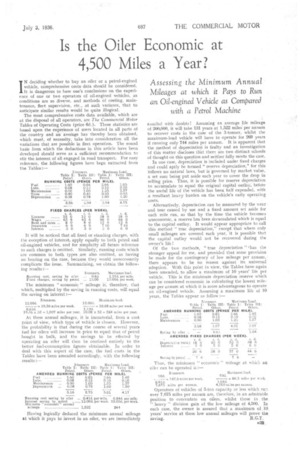Is the Oiler Economic at 4,500 Miles a Year?
Page 39

If you've noticed an error in this article please click here to report it so we can fix it.
Assessing the Minimum Annual Mileages at which it Pays to Run an Oil-engined Vehicle as Compared with a Petrol Machine IN deciding whether to buy an oiler or a petrol-engined vehicle, comprehensive costs data should be considered. It is dangerous to base one's conclusions on the experience of one or two operators of oil-engined vehicles, as conditions are so diverse, and methods of costing, maintenance, fleet supervision, etc., at such variance, that to anticipate similar results would be quite illogical.
The most comprehensive costs data available, which are at the disposal of all operators, are The Commercial Motor Tables of Operating Costs (price 6d.). These statistics are based upon the experience of users located in all parts of the country and an average has thereby been obtained, which must, of necessity, take into consideration all the variations that are possible in fleet operation. The sound basis from which the deductions in this article have been developed should serve as a sufficient recommendation to stir the interest of all engaged in road transport. For easy reference, the following figures have been extracted from the Tables:
It will he noticed that all fixed or standing charges, with the exception of interest, apply equally to both petrol and oil-engined vehicles, and for simplicity all future reference to such charges is omitted. Similarly, running costs which are common to both types are also omitted, as having no bearing on the case, because. they would unnecessarily complicate the issue. Summarizing, we obtain the following results :
Running cost., saving by oiler ... 0.6.2 1.194. per mile.
Fixed charges, saving by petrol ... 12.00 12.000. per week. The minimum " economic " mileage is., therefore, that which, multiplied by the saving in running costs, will equal the saving on interest :
19.36 x 52 = 1,007 tulles per year. 10.08 a 52 = 524 miles per year. At these annual mileages, it is immaterial, from a cost point of view, which type of vehicle is chosen. However, the probability is that during the course of several years fuel for oilers will increase in price to equal that of petrol bought in bulk, and the savings to be effected by operating an oiler will then be confined entirely to the better fuel-consumption figures obtainable. In order to deal with this aspect of the case, the fuel costs in the Tables have been amended accordingly, with the following results : Having logically deduced the Minimum annual mileage at 'Which it pays to invest in an oiler, we are immediately
assailed with doubts ! Assuming an average life mileage of 200,000, it will take 131 years at 1,522 milesper, annum to recover costs in the cake of the 3-tonner, whilst the maximum-load vehicle will have to operate for 96-9 years if running only 744 miles per annum. It is apparent that the method of depreciation is faulty and an investigation of this matter discloses that there are two distinct schools of thought on this question and neither fully meets the case.
In one case, depreciation is included under fixed charges and could aptly be termed " reserve depreciation," for this follows no natural laws, but is governed by market value, a set sum being put aside each year to cover the drop in selling price. Thus, it is possible for reserve depreciation to accumulate to equal the original capital outlay; before the useful life Of the vehicle has been half expended, with a resultant heavy burden on the vehicle's early operating costs.
Alternatively, depreciation can be measured by the wear • and tear caused by use and a fixed amount set aside for each mile run, so that by the time the vehicle becomes uneconomic, a reserve has been accumulated which is equal to the capital outlay. It would appear appropriate to call this method " true depreciation," except that where only small mileages are covered each year, it is possible that the capital outlay would not be recovered during the owner's life !
Of the two methods, " true depreciation ")has the stronger appeal for me, and provided that sonic provision be made for the contingency of low mileage per annum, there appears to be no reason against its universal adoption. With this point in view, the Tables have again been amended, to allow a maximum of 10 years' life per vehicle. This is the minimum depreciation reserve which can be considered economic in calculating the lowest mileage per annum at which it is more advantageous to operate an oil-engined vehicle. Assuming a maximum life of 10 years, the Tables appear as follow : Thus, the minimum " economic " mileage at which an oiler can be operated is :- 3-tonn era Maximum load. 90d.905. -=147.6 mites per week. = 86.5 miles per w?ek. 0.614. 1.040. 7,675 miles per annum. 4,500 miles per album.
Operators of vehicles of 3-ton capacity or less which run over 7,675 miles per annum are, therefore, in an admirable position to concentate. on oilers, whilst those in the. " heavy" division gain at the low mileage of 4,500. In each case, the owner is assured that a maximum of .10, years' service at these low annual mileages will prove the
saving. R.G.T.




















































































